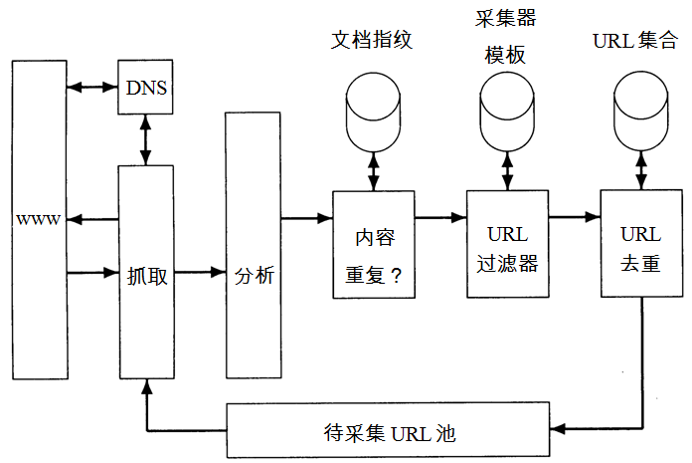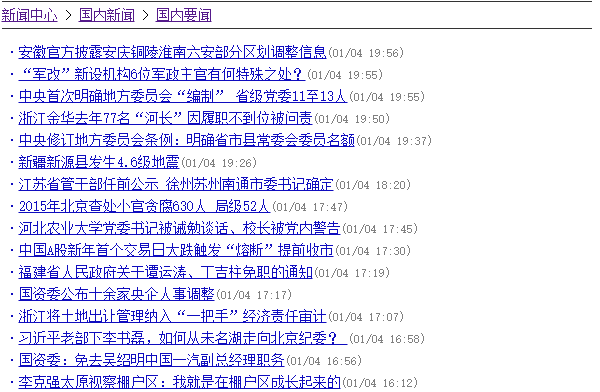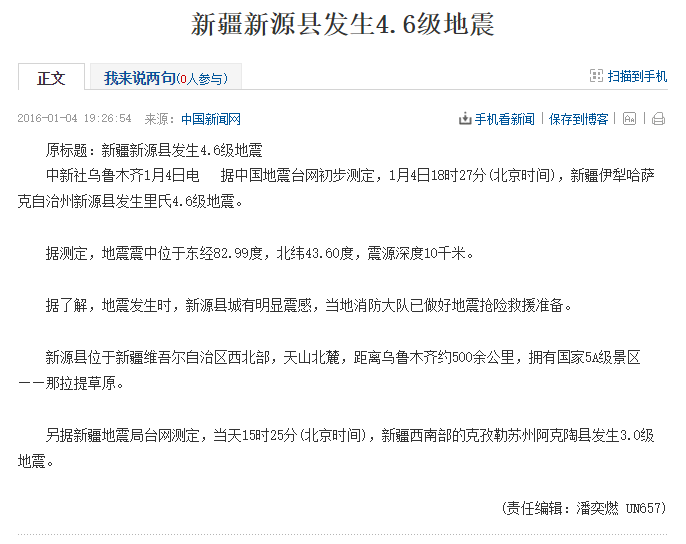网络爬虫又称网络蜘蛛、Web采集器等,它是一种按照一定的规则,自动地抓取万维网信息的程序或者脚本。
我们在设计网络爬虫的时候需要注意两点:
鲁棒性。Web中有些服务器会制造采集器陷阱(spider traps),这些陷阱服务器实际上是Web页面的生成器,它能在某个域下生成无数网页,从而使采集器陷入到一个无限的采集循环中去。采集器必须能从这些陷阱中跳出来。当然,这些陷阱倒不一定都是恶意的,有时可能是网站设计疏忽所导致的结果。
礼貌性。Web服务器具有一些隐式或显式的政策来控制采集器访问它们的频率。设计采集器时必须要遵守这些代表礼貌性的访问政策。
采集器的基本架构如下图所示。

基本上是“抓取→分析→得到新的URL→再抓取→再分析”这样一个死循环过程。
以上内容摘自王斌老师翻译的《信息检索导论》课本。
由于我们要做的是一个新闻搜索引擎,所以抓取的是新闻数据,对于爬虫,网上也有很多的开源程序,如nutch等,Github上还有人专门开发了抓取新闻的组件newspaper,可以很方便的提取新闻标题、正文、时间等信息。不过用python写爬虫也是分分钟的事情,下面我们一起来试一试。
首先找一个新闻网站,为简单起见,要找那种结构清晰、html代码便于解析的门户网站,比如搜狐新闻、参考消息等。
搜狐新闻的国内要闻列表如下:

结构非常清楚,左边是带URL的标题,右边括号里有新闻时间。这一页列表就有200条新闻,如果我们要获取1000条,只要不断模拟点击下一页即可。下一页的URL也只是在首页的基础上加上_xxx.shtml,xxx就是不同的页码。
查看列表的html源码,得知列表都在类名为newsblue1的td中,所以只需要解析html源码就可以得到新闻标题、URL和时间,python解析html可以用BeautifulSoup包,非常方便。
进入到新闻详细页面,正文部分如下:

查看html源码,正文位于类名为text clear的div中,据此可以很方便的提取新闻正文。
得到一条新闻的所有数据之后,我们需要将之结构化成xml文件,借助相应的xml包可以很方便的完成这项工作。xml格式定义如下:

注意爬虫需要访问网络,难免会出现一些异常,所以捕获异常是非常有必要的。另外,搜狐每篇新闻正文后面都会有一段’//’开始的注释,这个需要过滤掉,短于140个字的新闻我也过滤掉了。整个搜索系统的配置参数都存储在config.ini文件中。
下面是完整的python 3.4+代码。
1
2
3
4
5
6
7
8
9
10
11
12
13
14
15
16
17
18
19
20
21
22
23
24
25
26
27
28
29
30
31
32
33
34
35
36
37
38
39
40
41
42
43
44
45
46
47
48
49
50
51
52
53
54
55
56
57
58
59
60
61
62
63
64
65
66
67
68
69
70
71
72
73
74
75
| # -*- coding: utf-8 -*-
"""
Created on Sat Dec 19 11:57:01 2015
@author: bitjoy.net
"""
from bs4 import BeautifulSoup
import urllib.request
import xml.etree.ElementTree as ET
import configparser
def get_news_pool(root, start, end):
news_pool = []
for i in range(start,end,-1):
page_url = ''
if i != start:
page_url = root +'_%d.shtml'%(i)
else:
page_url = root + '.shtml'
try:
response = urllib.request.urlopen(page_url)
except Exception as e:
print("—–%s: %s—–"%(type(e), page_url))
continue
html = response.read()
soup = BeautifulSoup(html)
td = soup.find('td', class_ = "newsblue1")
a = td.find_all('a')
span = td.find_all('span')
for i in range(len(a)):
date_time = span[i].string
url = a[i].get('href')
title = a[i].string
news_info = ['2016-'+date_time[1:3]+'-'+date_time[4:-1]+':00',url,title]
news_pool.append(news_info)
return(news_pool)
def crawl_news(news_pool, min_body_len, doc_dir_path, doc_encoding):
i = 1
for news in news_pool:
try:
response = urllib.request.urlopen(news[1])
except Exception as e:
print("—–%s: %s—–"%(type(e), news[1]))
continue
html = response.read()
soup = BeautifulSoup(html)
try:
body = soup.find('div', class_ = "text clear").find('div').get_text()
except Exception as e:
print("—–%s: %s—–"%(type(e), news[1]))
continue
if '//' in body:
body = body[:body.index('//')]
body = body.replace(" ", "")
if len(body) <= min_body_len:
continue
doc = ET.Element("doc")
ET.SubElement(doc, "id").text = "%d"%(i)
ET.SubElement(doc, "url").text = news[1]
ET.SubElement(doc, "title").text = news[2]
ET.SubElement(doc, "datetime").text = news[0]
ET.SubElement(doc, "body").text = body
tree = ET.ElementTree(doc)
tree.write(doc_dir_path + "%d.xml"%(i), encoding = doc_encoding, xml_declaration = True)
i += 1
if __name__ == '__main__':
config = configparser.ConfigParser()
config.read('../config.ini', 'utf-8')
root = 'http://news.sohu.com/1/0903/61/subject212846158'
news_pool = get_news_pool(root, 854, 849)
crawl_news(news_pool, 140, config['DEFAULT']['doc_dir_path'], config['DEFAULT']['doc_encoding'])
print('done!')
|
完整可运行的新闻搜索引擎Demo请看我的Github项目news_search_engine。
以下是系列博客:
和我一起构建搜索引擎(一)简介
和我一起构建搜索引擎(二)网络爬虫
和我一起构建搜索引擎(三)构建索引
和我一起构建搜索引擎(四)检索模型
和我一起构建搜索引擎(五)推荐阅读
和我一起构建搜索引擎(六)系统展示
和我一起构建搜索引擎(七)总结展望



